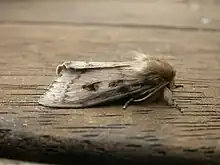| Leptocneria reducta | |
|---|---|
 | |
 | |
| Scientific classification | |
| Kingdom: | |
| Phylum: | |
| Class: | |
| Order: | |
| Family: | |
| Subfamily: | |
| Genus: | |
| Species: | L. reducta |
| Binomial name | |
| Leptocneria reducta (Walker, 1855) | |
| Synonyms | |
| |
Leptocneria reducta, the white cedar moth, is a moth of the subfamily Lymantriinae. The species was first described by Francis Walker in 1855.[1][2] It is found in all of Australia, except Tasmania.
.jpg.webp)
Larva
The wingspan is about 45 mm for females and 35 mm for males.
The larvae feed on Melia azedarach.[3]
The caterpillars live communally. They come out of hiding in the evening when they swarm the tree trunk and the branches to get to the leaves, which they eat. The caterpillars feed communally until the tree becomes defoliated. At this point they will start searching for a new host, sometimes invading buildings in their search.
The caterpillars are covered in bristles, inducing an allergic reaction (urticaria) with some people.
References
- ↑ "Species Leptocneria reducta (Walker, 1855)". Australian Faunal Directory. Archived 5 April 2011.
- ↑ Savela, Markku (29 May 2011). "Leptocneria reducta (Walker, 1855)". Lepidoptera and Some Other Life Forms. Retrieved 25 March 2020.
- ↑ Herbison-Evans, Don & Crossley, Stella (12 January 2016). "Leptocneria reducta (Walker, 1855) White Cedar Moth". Australian Caterpillars and their Butterflies and Moths. Retrieved 25 March 2020.
This article is issued from Wikipedia. The text is licensed under Creative Commons - Attribution - Sharealike. Additional terms may apply for the media files.